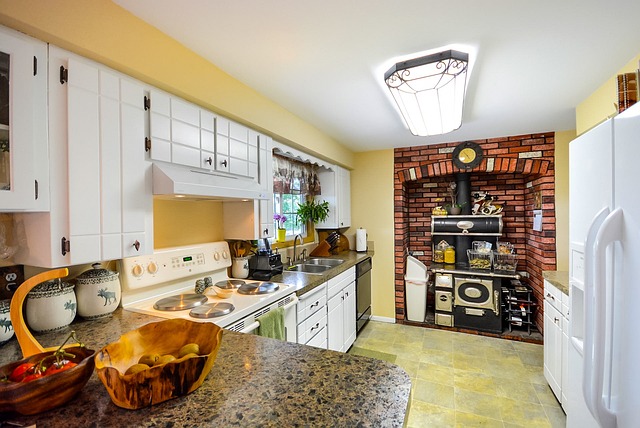Open kitchen layouts enhance air circulation and reduce cooling needs, boosting energy efficiency. Strategic design including low-energy lighting and energy-efficient appliances minimizes environmental impact, aligning with sustainable kitchen renovations. Eco-friendly materials, natural light maximization, and green upgrades like LED fixtures contribute to a stylish, eco-conscious space that saves on utility bills while promoting a greener lifestyle.
Designing an open layout for your kitchen remodel can significantly improve air circulation and reduce cooling needs. This article explores how an open floor plan enhances ventilation while introducing strategies for a sustainable kitchen. We delve into the integration of energy-efficient appliances, the role of low-energy lighting, eco-friendly materials, and maximizing natural light to achieve a green kitchen renovation that saves energy and minimizes environmental impact. Discover practical tips for creating an energy-efficient kitchen design that benefits both your wallet and the planet.
Understanding the Impact of Open Layouts on Air Circulation
Open layouts have become a popular design choice in modern kitchens, and for good reason. By eliminating walls and creating a seamless flow, these spaces enhance both functionality and aesthetics. However, beyond its visual appeal, an open layout plays a pivotal role in improving air circulation and reducing cooling needs, ultimately contributing to a kitchen remodel’s energy efficiency.
In the realm of eco-friendly kitchen upgrades, strategic design decisions can significantly impact a space’s environmental footprint. For instance, low-energy lighting for kitchens, coupled with energy-saving kitchen appliances, becomes more effective in an open layout due to better airflow. This promotes a comfortable indoor climate, reducing the reliance on air conditioning and, consequently, saving energy costs. A sustainable kitchen renovation focused on these principles not only creates a healthy living environment but also aligns with green practices.
Incorporating Energy-Efficient Kitchen Appliances
Incorporating energy-efficient kitchen appliances is a key component of any kitchen remodel aimed at enhancing sustainability and reducing utility costs. When planning a green kitchen renovation, swapping out old appliances with energy-saving models should be a top priority. These modern devices are designed to consume less electricity, making them an excellent investment for both your wallet and the environment. From low-energy lighting for kitchens to advanced refrigeration systems, each upgrade contributes to a more eco-friendly space.
A kitchen’s layout plays a significant role in optimizing air circulation, which is further enhanced by these energy-efficient appliances. Well-placed vents and fans, combined with careful design, can significantly reduce the need for cooling. This not only minimizes energy usage but also creates a healthier living environment. By combining an open layout, strategic ventilation, and energy-saving appliances, you’ll achieve a sustainable kitchen that is both stylish and efficient.
The Role of Low-Energy Lighting in Sustainable Kitchens
In today’s pursuit of sustainable living and energy efficiency, designing a kitchen with both style and environmental consciousness is more important than ever. A key component in this effort is adopting low-energy lighting solutions during a kitchen remodel for energy efficiency. Energy-efficient kitchen design goes beyond aesthetics; it involves integrating eco-friendly kitchen upgrades that minimize the building’s carbon footprint. By choosing energy-saving kitchen appliances and implementing green kitchen remodeling techniques, homeowners can significantly reduce their cooling needs and overall energy consumption.
Low-energy lighting for kitchens is a practical and stylish way to achieve this balance. LED bulbs, for instance, are long-lasting and highly efficient, consuming far less electricity than traditional incandescent lights. This simple upgrade not only reduces utility bills but also contributes to a sustainable kitchen environment. Additionally, well-designed lighting schemes can enhance the functionality of the space, making tasks like food preparation and cooking more enjoyable while further reducing the need for excessive cooling.
Eco-Friendly Materials and Finishes for a Green Renovation
When designing an open layout to promote better air flow and reduce cooling demands, choosing eco-friendly materials and finishes plays a significant role in achieving both energy efficiency and a harmonious indoor-outdoor connection. Opting for sustainable kitchen renovations involves selecting natural, non-toxic products that not only minimize environmental impact but also contribute to a healthier living space.
Integrating energy-saving kitchen appliances, such as low-energy lighting fixtures and efficient flooring options, further enhances the green profile of your remodel. Low-energy lighting for kitchens, for instance, can significantly lower utility bills while reducing carbon footprint. Additionally, incorporating materials like bamboo, reclaimed wood, or recycled glass not only adds aesthetic appeal but also ensures that your kitchen renovation aligns with current eco-conscious trends in home design.
Maximizing Natural Light for Reduced Energy Consumption
Maximizing natural light is a key strategy in designing an open layout that promotes air circulation and reduces cooling needs. Large, well-placed windows and skylights can significantly decrease energy consumption by harnessing the power of sunlight to illuminate and heat interior spaces during the day. This not only cuts down on electricity bills but also contributes to a more eco-friendly kitchen environment.
When planning a kitchen remodel for energy efficiency, consider incorporating energy-saving kitchen appliances that are designed with sustainability in mind. Opting for low-energy lighting for kitchens, such as LED fixtures, can further reduce power usage without compromising on brightness or aesthetics. These simple yet effective upgrades can make your kitchen renovation a sustainable one, ensuring a comfortable and energy-efficient space while promoting a greener lifestyle.
A well-designed open layout not only creates a visually appealing and spacious kitchen but also significantly improves air circulation, reducing cooling needs and energy consumption. By incorporating energy-efficient appliances, low-energy lighting, eco-friendly materials, and maximizing natural light, a kitchen remodel for energy efficiency becomes both practical and sustainable. These green kitchen upgrades not only contribute to a healthier living environment but also offer long-term savings, making it a wise investment for any homeowner looking to reduce their carbon footprint.
